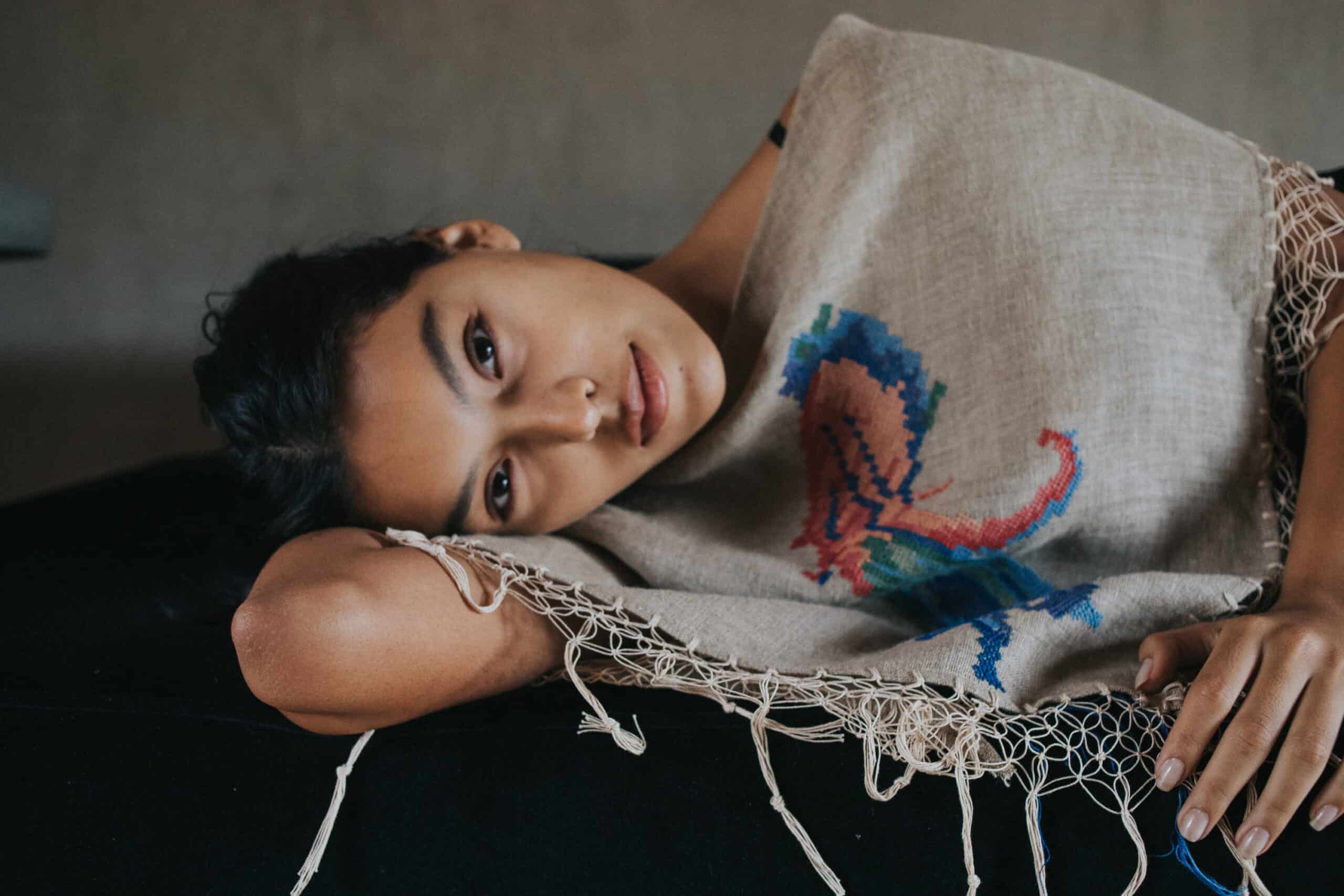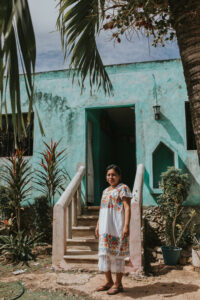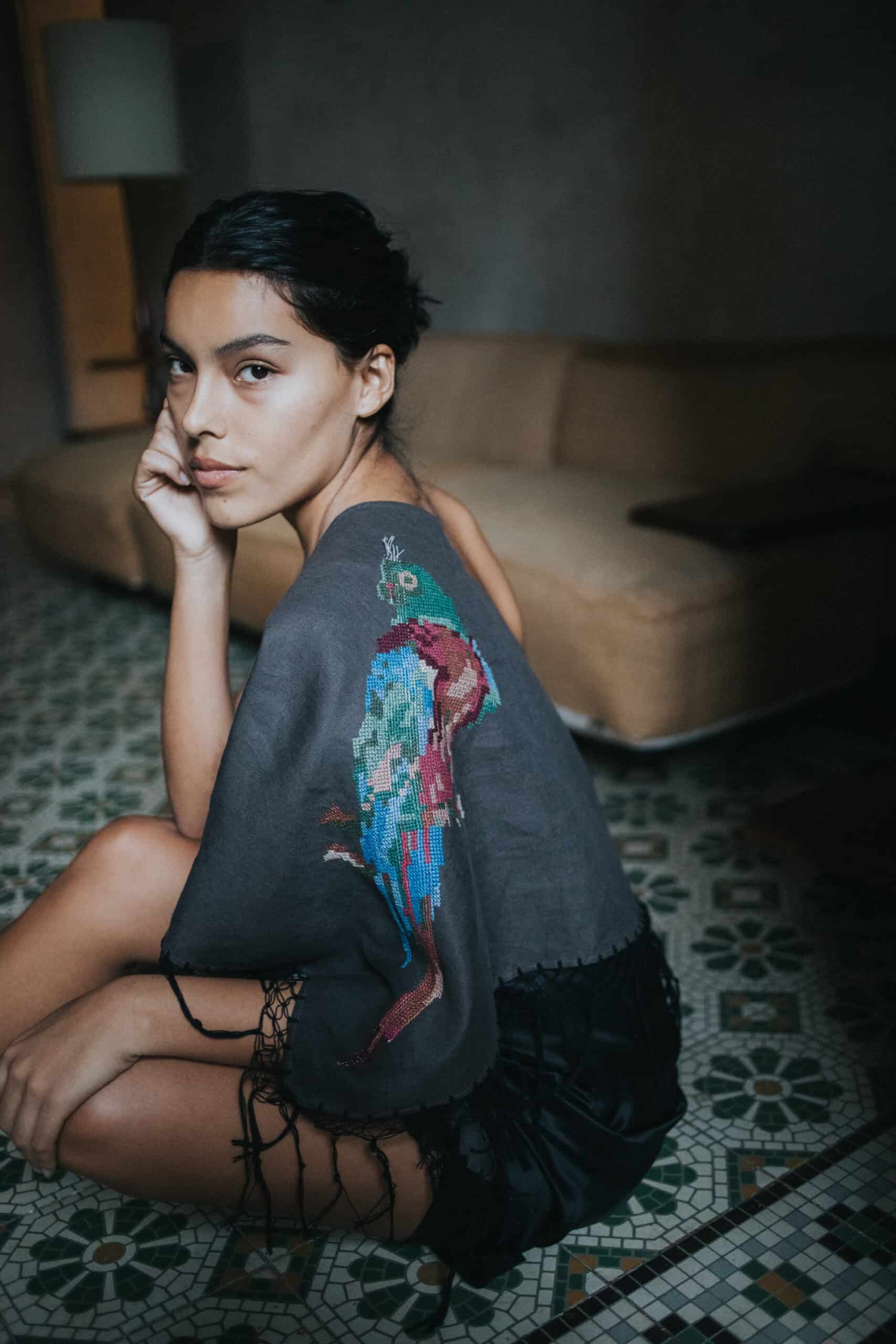
The macaw and the quetzal
I, Moon, want to tell you the story of three women who embroidered magic.
They were artisans and worked in the patio of their workshop in Mexico. People knew them: they spent their days and nights dedicated to embroidering pieces with which they dressed the community.
The years had made their hands dexterous. Their fingers moved quickly as they threaded the threads through the eye of a needle; with precision when transferring the fabric with the metallic tip with which they joined thread after thread in fine embroideries. With their hands they also weaved and knotted fibers that resulted in accessories as well as hammocks for taking a nap.
One day a macaw appeared in front of their yard. It stopped in the branches of a tree and stopped to contemplate them. Then it flew to another tree, always staring at them. The scene went on like this for hours: the bird looking at them, moving among the branches of their patio. Hours turned into days, days into weeks, weeks into months.
Little by little the artisans got used to its presence. After a while, they noticed that a quetzal had joined the macaw. The duo of birds remained in front of them, danced among the branches of the trees, emitted trills, and watched them.
After listening to nothing else but the bird’s singing, one of the women thought she understood their language. “They want us to embroider their figure,” she told her companions, who were still immersed in the embroidery.
On the night of the new moon, they left on the ground the pieces they were working on and dedicated their days and nights to transferring the shapes of the birds to the fabrics.
They went on like this for weeks until the full moon came. That night they began to embroider, weave and knot as they always had. They were so focused that they didn’t realize the moment in which both birds released the plumage of their wings in the buttonhole of their needles; nor did they see when they skinned their colorful body into the textile fibers they had in their workshop.
They finished the pieces and the result took them by surprise. It was the spitting image of birds. When they looked again at the landscape in their yard, they discovered that the birds had disappeared. They never came back. A macaw and a quetzal. Mythical animals do mythical things.
Process
A series of coincidences triggered our collaboration 23, called Xiik’ (a word that in Mayan language means wing).
The story of this project began three years ago, in 2020, when Sharon Drijanski, Loona’s, discovered the photographs of a piece that caught her attention.
She was looking at CHIJ a textile work created under an upcycling philosophy, and that had been crafted in Chiapas, as a collaboration between two artisans from that state, Martidiana Méndez Jiménez and Eustaquia Jiménez Méndez, and the Argentine designer Natalia Tannenbaum.
The piece was exhibited in Bosque de Chapultepec, at Espacio CDMX, Arquitectura y Diseño, and was presented as part of the “Inédito” exhibition part of Design Week Mexico’s program.
There, Sharon found an impressive piece completely embroidered by hand that measured more than eight feet long and was made up of three layers of textiles, which were the result of a recycling proposal that reused blouses from the Chiapas community of Catishtic (a town located an hour and a half from Tuxtla Gutiérrez) and that didn’t have a commercial outlet.
The narrative of this work appealed to Sharon, so she reached out to Natalia and invited her to develop a Collaboration in Loona. Natalia’s projects are characterized by being collaborative, pluralistic, and feminine, three elements she noticed in Loonas invitation, one she immediately accepted.
Natalia, designer and textile artist born in Argentina in 1981, has a master’s degree in Flat Weaves, Jacquard and Prints from Paris’ National School of Industrial Creation (ENSCI). For more than a decade she worked as a colorist, as a development manager and as a designer at fashion houses such as Hermès, Du Pareil au Même, and Descamps.
Her next stop after France would be Mexico City, and a couple of years ago she moved to Mérida, where she currently resides. From there her work maintains her same interest, she aims to create textile pieces that seek to exalt the passage of time, to show the artisan luxury and the richness of unique fabrics that are handcrafted by Mexican artisans.
When outlining the project, Natalia and Sharon immediately evoked textile garments that had an emotional component. Wardrobe pieces that are kept for years and whose sentimental value goes beyond utility. Fabrics that go beyond time and acquire a symbolic value for the person who treasures them.
“It’s a work of art”, says Sharon in an interview, “we were inspired by a shawl from my collection, from the time when Missoni was just starting out”, she recalls about the first creative decisions for this Collaboration.
“A shawl is used as a coat but also as an accessory; as a decorative element that can last. It’s timeless”, says Natalia about the virtues of a design like this.
In Xiik’, Natalia wanted to honor the calm that’s inherent to the creation process of artisan pieces and respect time and the relationships that are woven, therefore she decided to work with Mayan artisans from the peninsula. This is the first time that Natalia has collaborated with Yucatecan artisans.
To have the right allies, she visited various localities in the peninsula to find the women who wanted to participate in this adventure. Two of them accepted the challenge: Lili Ucan, a cross-stitch embroiderer, and Ligia González Muñoz, a macramé artisan.
With great enthusiasm, openness and freedom, Lili, Ligia and Natalia decided that it was possible to craft the pieces as a six hand labor from places such as Mérida, Teabo and Tixkokob.
For decades, Lili has used the cross-stitch embroidery technique (or xok bil chuuy) to decorate the huipiles worn by some women in the region. In this project, she uses that same technique to give life to a collection of six unique shawls that explore elements of the Yucatecan fauna. These are, Natalia points out, “techniques that require great precision and patience: each stitch is a celebration of time that passes and passes, and never ends”.
About the design, Natalia remembers that it arose from a personal hobby: from time to time she takes pictures of mosaics of old houses located in the center of Merida. One day she spotted in that series a macaw and a quetzal, which are the motifs that appear on the shawls. “The animals, pixelated in the mosaics, lend themselves perfectly to being adapted in cross stitch, a technique in which the grid is used as a basis for embroidery,” says Natalia.
The materials with which the pieces are made endorse their artistic character. Each one has an Italian linen base and is decorated with high-quality cotton thread. Each one required more than 30 hours of work.
They are also reversible pieces. The work on the back has had the same care as that on the front; the bird appears on both sides of the shawl with different stitches.
“The threads that were left over from the design were not cut, they appear loose like the print of each color that was used to embroider the motif and emulate the plumage of the birds on the shawl. The macramé finish emulates the wings of birds”, says Natalia about the technical virtuosity and the hand gesture both which lie behind each piece.
About this Collaboration, the designer concludes: “Xiik’ means wing in Mayan. These pieces rise, take flight and make us fly together, they invite us to dream constantly and to keep collaborating among women. Forming bonds and weaving threads that connect us”.
Collaborators

Natalia Tannenbaum
Designer and textile artist born in Argentina in 1981. She holds a master’s degree in Flat Weaves, Jacquard and Prints from the National School of Industrial Creation (ENSCI) in Paris. For more than a decade she worked as a colorist, developer and designer at fashion houses such as Hermès, Du Pareil au Même and Descamps. She currently lives in Mexico where she works on collaborative, plural and feminine projects.

Ligia González Muñoz

Lili Ucan
Masters artisan women from Teabo and Tixkokob, Yucatán. Lili is an expert in the cross-stitch embroidery technique, a job that requires a lot of patience and precision; For her part, Ligia finds in her hands the perfect tools to create the knots that give life to her favorite technique, macramé.

Nuria Lagarde
Her photographs are presented as short stories: tales that never tell everything they expose and that always leave elements open to interpretation. She grew up among whales and salt, in Baja California Sur, Mexico and studied Art History at Casa Lamm. Currently she works between Mexico and Paris. In addition to her personal projects, she collaborates for different magazines. In 2020, she captured the images from the book “The Food of Oaxaca”, published by Alfred A. Knopf.
Shop the collection

XIIK'
These pieces have an Italian linen base and are decorated with high-quality cotton thread. Each piece took more than 30 hours of work.
They are reversible pieces, the work on the back is of the same fineness as the front; the bird appears on both sides of the shawl with different stitches.
The threads that were left over from the design were not cut, they appear loose like the print of each color that was used to embroider the motif and emulate the plumage of the birds on the shawl.
The macrame finish emulates the wings of birds.
Xiik’ means wing in Maya. These pieces rise, take flight and make us fly together and continue dreaming and collaborating among women.
Tending ties, and weaving threads that connect us.
·Materials: 100% linen base, 100% cotton thread.
·Technique: cross stitch and macrame embroidery.
·Lili Ucan made the cross stitch embroidery in Teabo, Yucatán.
·Ligia Graciela Gonzales Muñoz carried out the work in macrame in Tixcocob, Yucatán.
·Measurements: 55” x 20” inches
Nosotros Tienda Colaboración actual Términos y condiciones
© Loona | Todos los derechos reservados | info@loonauniverse.com
























































































